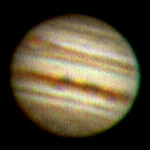
Jupiter's Great Red Spot
The Great Red Spot (GRS) on Jupiter is thought to be a giant storm that's been going on for more than two hundred Earth years. In recent years its colour seems to have been fading and it is no longer as prominent as it once was. In fact many amateur astronomers have never even seen it, or may think that they have seen it but are not quite sure. Until this exercise that I am relating below, I myself have never seen it visually. Some time ago I took some RGB images of Jupiter with an SBIG 237 astronomical CCD. It was only when I had more or less finished processing the images that I realized that I had captured it in the image below (the "bubble" near the upper left edge).

Visually, there is currently very little contrast between the GRS and the adjacent cloud bands; so unless you know where to look, you simply miss it. It shows up more easily in photographs that have been contrast-stretched enormously, like in the image above. Determined to see it visually, I checked out "Sky & Telescope" magazine for the time when it would be smack in the middle of Jupiter's face, ie the time when it crosses Jupiter's central meridian. Turned out quite convenient, 2200 Oman time on 4th February 2002. So off I went to the roof and took photos with a Canon EOS D30. My Celestron Ultima 2000-8" was configured for f50 using a Televue 5x Powermate. Effectively I was shooting using a 10,000mm focal length lens at f50. The seeing and images were not particularly great and I decided to switch to my usual tried-and-tested eyepiece projection, using a 7mm Nagler (effective focal length 24000mm at f120). All photos below were taken with this configuration. First, a word about seeing the GRS visually. It really is very faintly demarcated. So you really ought to know it is there, in advance. The image below is an attempt to replicate what I saw visually. In addition there was, of course all the shimmering. Now you see it, now you don't. Basically, the seeing was not all that great. Anyway, the GRS is near the central meridian. See it?

Well, actually its visibility improves slightly by using a blue filter at the eyepiece:

To be honest though, during the shimmering you do get to see a hint of a sharper edge every now and again. But I can now say with confidence that I have finally, definitely, seen the GRS with my own eyes. I took a huge number of photos and from these I have constructed the animation below. Each of the constituent frames (half hour time steps) is actually a composite of 4 photos which was then contrast-stretched, sharpened, etc. Image capture was by RAW in the D30, white balance set at "daylight", colour saturation and contrast "high". Finally the images were shrunk down to a 100 pixels wide. Noise in the images is due to the excessive amount of sharpening that's required to reveal stuff. Compare with the preceding unsharpened images. Here is Jupiter's Great Red Spot doing its thing between 2130 and 2400 on 4th February 2002. Yes the planet does rotate that much in just 2.5 hours!:

For other stuff return to Samir's Home
To drop me an e-mail just
click on:
samirkharusi